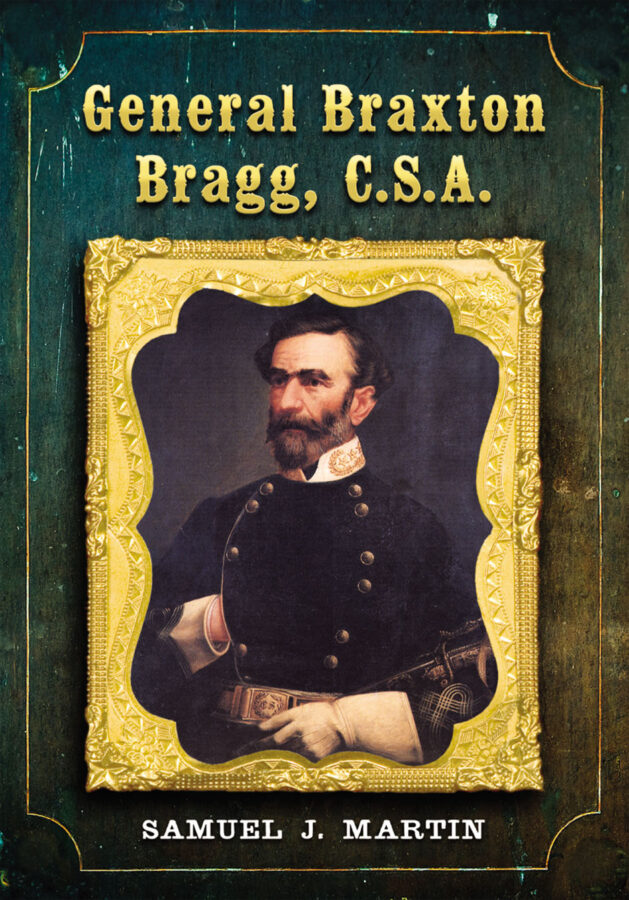General Braxton Bragg, C.S.A. by Samuel J. Martin. McFarland, 2011. Cloth, ISBN: 0786459344. $55.00.
 A consensus among many Civil War historians is that the Confederacy lost the conflict in the West, the vast region between the Appalachian Mountains and the Mississippi River. Union armies and fresh water navy secured the network of rivers and penetrated deep into the Confederate heartland, culminating with the capture of Atlanta in September 1864. Although the war lasted another eight months, southern hopes for independence were doomed.
A consensus among many Civil War historians is that the Confederacy lost the conflict in the West, the vast region between the Appalachian Mountains and the Mississippi River. Union armies and fresh water navy secured the network of rivers and penetrated deep into the Confederate heartland, culminating with the capture of Atlanta in September 1864. Although the war lasted another eight months, southern hopes for independence were doomed.
At the center for much of this record of Confederate failures and defeat stands Braxton Bragg. He commanded the main force in the region, the Army of Tennessee, from June 1862 to the end of November 1864. In that time, his troops won only one signal victory at Chickamauga in September 1864. In turn, history has been less than kind to Bragg. His name often appears on a list of the conflict’s worst generals.
Like many of Bragg’s contemporaries, historians have found him to be an unappealing, if not unlikeable, man and officer. Bragg could be quarrelsome, petty, disdainful, and vindictive, a martinet in uniform. As an army commander, he was reviled by subordinates, considered too harsh as a disciplinarian, and sought scapegoats for the army’s failures. It is a portrait accurate in most details, but frequently not fully painted.
A native North Carolinian, Bragg was devoted unquestionably to the Confederate cause and cared deeply about the welfare of his officers and men. Except for a six-year period when he owned a Louisiana plantation, Bragg had been a professional soldier for more than two decades prior to the Civil War. He distinguished himself in Mexico and against the Seminoles in Florida. By training and experience, Bragg was an able administrator and could fashion strategic movements and tactical arrangements.
Bragg’s capabilities as a soldier have been overshadowed, however, by the historical record of him as an army commander. Perryville, Stone’s River, Lookout Mountain, and Missionary Ridge are all entries on a ledger of defeats. To be sure, blame for these defeats does not rest solely upon Bragg’s alleged incompetence but also upon a coterie of inept senior subordinates. The mettle and fighting prowess of the army’s rank and file were proven on bloody battlefields, but the army’s curse lay with its leadership.
In this lengthy and well-researched new biography of Bragg, Samuel Martin attempts to rectify the Confederate general’s historical record and reputation. It is a commendable effort by the veteran author that will assuredly stir further debate and controversy. Martin’s central theme in his study of Bragg’s tenure as commander of the Army of Tennessee is that primary blame for the command’s defeats rest with an array of disobedient and incompetent subordinates. The author charges further that their dislike, even hatred, of Bragg and their attempts to cover up their own failings resulted in postwar accounts that have distorted assessments of Bragg’s generalship by subsequent historians.
According to Martin, Bragg’s enemies within the army constituted a lengthy list, men such as Leonidas Polk, William Hardee, Simon Buckner, E. Kirby Smith, John Breckinridge, Nathan Bedford Forrest, Daniel Harvey Hill, and James Longstreet. Martin attributes the difficulties between Bragg and some of the generals to personal clashes in the antebellum army. If true, a reader is left to believe that the old wounds festered for years, if not decades, before poisoning Bragg’s relationships with these officers. Martin alleges, for example, that Longstreet held a grudge against Bragg since 1861 over the latter’s treatment of Richard Anderson, who had served under Bragg at Mobile. The author makes this charge without documentation in his notes.
Martin is not unsparing in his criticisms of Bragg, the man and the general. The author’s conclusion on Bragg’s generalship is as he stated: “It appears then that Bragg has been maligned by history, that the instances where he failed in the field were the fault of his subordinates. This presumption, however, ignores the fact as their commander, he was responsible for his officers’ actions. And Bragg could have done more to assure their and his success” (475).
The author’s research is commendable. The bibliography includes an array of manuscript sources, newspapers, published and unpublished memoirs, letters, and diaries, and government documents. He effectively paints an intimate portrait of Bragg and his wife, Elise Ellis Bragg, with the use of their extensive correspondence. The result is a Bragg not often remembered in accounts of the war.
Unfortunately, the narrative is replete with factual errors and misspellings. It is sorely in need of editing. A few examples include calling Jefferson Davis President when he was Secretary of War; misdating the Battle of Fredericksburg, claiming all Republicans in the 1850s were abolitionists; wrong on the number of seceded states in early 1861; and designating John Pope’s Army of Virginia as the Army of the James.
The maps are simplistic and crudely drawn, giving only geographic locations on battlefields. Consequently, the battle narratives are confusing. The author also chose to organize the narrative into rather brief chapters. In all, the book consists of fifty-five chapters and an epilogue.
Braxton Bragg has deserved a balanced and critical biography for a long time. According to the author, he devoted eight years to the research and writing. In the end, however, the result is marred by unnecessarily detailed combat descriptions that make for tedious reading, many factual errors and misspellings, and inadequate maps. There is much that is good in this book and much that needed editing.
